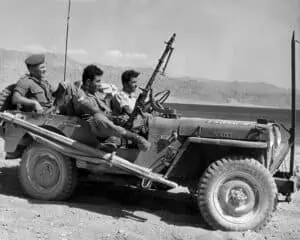Israeli Carry Isn’t Really Useful
In 1947, the nation of Israel was reborn in the center of the Middle East. Founded as a home for Jewish people scattered all over the world, it has had to fight many wars during its short existence. As such, the men and women of the Israeli Defense Force (IDF) have gained a fearsome reputation as warriors. The techniques and skills they learned in defending their homeland are in high demand around the world. One particularly well-known technique of the IDF is carrying a defensive pistol with a full magazine but no round chambered. We call this empty chamber carry or “Israeli carry”.
What is Israeli Carry
Israeli carry, or carrying a defensive pistol with no round chambered, didn’t actually start with the Israelis. For instance, it was common practice in the Old West to carry only five rounds in a single-action six-shooter. The empty chamber in the cylinder was positioned under the firing pin so a sharp blow on the back of the hammer wouldn’t be transferred to the chambered cartridge, causing an accidental discharge.
Put a pin in that safety idea. We’ll come back to it later.
The practice of empty chamber carry continued with the introduction of magazine-fed, semi-automatic pistols. In the 1930’s, W.E. Fairbairn and E.A. Sykes wrote their highly influential book, “Shooting To Live,” based on their experiences with the Shanghai Police Department. In that book, they suggest that the proper way to carry a semi-automatic pistol is with a full magazine in the gun, but without a round in the chamber.

The Israelis received literally boatloads of guns like the Czech vz27 pistol, chambered in .32ACP
Sykes and Fairbairn would both go on to play influential roles in training and equipping Allied armies during World War II. It turned out to be quite common for armies on both sides of WWII to train their soldiers to carry a pistol on an empty chamber. A U.S. Army Field Manual on the 1911A1 pistol from 1940 reinforces this idea. On page 19, the manual recommends that, “In campaign, when early use of the pistol is not foreseen, it should be carried with a fully loaded magazine in the socket, chamber empty, hammer down.”
However, when action is imminent, the manual recommends carrying the 1911A1 with a round in the chamber and the safety engaged.
What Condition Is Your Pistol In
Let’s pause for a moment and talk about how we talk about loaded pistols. There are five ways to talk about where the ammunition is inside your gun and how the safeties are engaged (or not). Legendary author and firearms trainer Colonel Jeff Cooper laid out these five conditions. Many of us continue to use his terminology today.
Condition 0: You’ve inserted a loaded magazine into the firearm, there is a round in the chamber, and all safeties are off. A gun in this position is ready to go “BANG!” the instant you activate the trigger.
Condition 1: You have inserted the magazine, there is a round in the chamber, and you have engaged all appropriate safeties. Let’s be 100% clear about this: This is how all modern firearms are designed to be carried. Every single one of them. Continuing on…
Condition 2: You have inserted a magazine, loaded a round in the chamber, and the hammer is forward (i.e. uncocked). This applies to hammer-fired, Double Action/Single Action guns like some semi-automatic pistols and double-action revolvers.
Condition 3: The magazine is inserted but there is no round in the chamber. We call this “Israeli Carry.”
Condition 4: No magazine is inserted and no rounds are in the chamber. The pistol is nothing but a rather awkward paperweight.
How Israeli Carry Came To Be
There are two prevailing theories about how the Israeli Defense Forces adopted Condition Three carry (no round in the chamber) as their standard method of carrying a pistol.
The first theory is that they adopted this technique for safety reasons. For the first few years of the IDF’s existence, its equipment was mainly cast-off equipment from both sides of WWII. This led to the IDF having to integrate a wide variety of pistols into service. This, in turn, led to having to train troops how to use different pistols. These pistols may not always employ the same method of operation. Instructors believed standardizing on Condition Three carry was one way for the IDF to eliminate the confusion of training for various safeties and firearms functionality.

No, you’re not seeing things. These are Israeli soldiers armed with a German MG34 machine gun
The second theory behind the origin of Israeli carry is related to the guns that the IDF inherited from the combatants of WWII. For the first few years of its existence, the IDF did not have state of the art equipment. Rather, it used the gear that everyone else had declared surplus, and some of it was probably in questionable condition. If you’re not sure that the safety on your pistol actually works, (and there are no other pistols to be had at that moment), Condition Three carry makes a lot of sense. The theory is that the IDF started out with Condition Three carry for safety’s sake. Now, bureaucratic inertia keeps it going to this day.
A Third Theory of Israeli Carry
After researching for this article, I think there might be a third reason why Israeli carry came to be. I mentioned Skyes and Fairbairn’s ground-breaking work with the Shanghai police force. However, their work during World War II also had a lasting impression on firearms training. Their ideas and training methodology were used by the Allies’ elite commando groups, so much so that the fighting knife they designed, the Sykes-Fairbairn dagger, has become the symbol of elite units on both sides of the Atlantic. Their training included the idea that they carry a semi-automatic pistol in Condition Three. Experts considered this the best training available at the time. As such, it made sense that the newly-formed nation of Israel would look to their techniques to form the basis of their new military. They continue to teach many of those techniques to this day.
These are out-of-date techniques that, quite frankly, we shouldn’t use anymore. Let’s talk about why.
You Own a HANDgun, not a HANDS gun.
Full credit to my friend and fellow writer Tamara Keel for that great way of describing one of the biggest problems of chamber empty carry. Modern life is complex, and there is just no way we can be sure that we’ll have both hands empty if we need to use our sidearm for self-defense. Israeli carry requires you to rack the slide on your gun to chamber a round. This is usually with your support hand, sometime between when your gun clears your holster and when it is pointed at the target. This procedure assumes three things:
- We will see the threat and have enough time to clear the holster, rack the slide, and make a clean presentation towards the target.
- We will have both hands free to manipulate the gun.
- If we don’t have both hands free, we will have the time and opportunity to use our belt or holster or some other object to move the slide and chamber a round.
Right now, everyone who has done combatives, taken a force-on-force class, or has done any sort of training with airsoft or simunitions is chuckling to themselves. They know, as I do, that simulated gunfights (just like their real counterparts) can be a messy situation. Threats can pop up from close distances. These encounters require you to use one hand to fight off your attacker while the other hand is drawing your gun.
You might be holding a loved one with your support hand, or the attacker might grab this hand. Training for a wide variety of real-world situations is always a good idea. A surprise attack from close range is definitely a possibility for you to watch out for.
Safeties Work. Use them.
At the gun range where I used to work, we had a regular customer who carried a Sig Sauer P226 TacOps. This is a gun that I really, really like. I was surprised to see he carried it without a round in the chamber. So, I asked him why.
“I don’t trust myself,” was his answer. That answer puzzled me for a long time. That gun is very safe, and he was a trained, experienced shooter. Why wouldn’t he carry with a round in the chamber? Years later, I think I know why. I think that the idea of carrying a loaded firearm around is troubling to some people. If they carry it unloaded, they can tell themselves that they’re carrying an effective means of self-defense while saving themselves the worry of following the Four Rules Of Gun Safety while doing so.
Feeling Safe By Actually Being Safe
Carrying a defensive pistol without a round in the chamber is like riding a bicycle with training wheels attached. Actually, it’s worse than that. We design most training bikes to use training wheels. However, every single defensive pistol on the market today is designed to be carried with a round in the chamber. Carrying a defensive pistol any other way is literally using it in a way different from the manufacturer’s intent. Do the right thing: carry in Condition One.
The day and the hour of a potentially violent encounter will not be known to you. So, make sure that your defensive pistol is ready for use no matter what situation you are in. Live your life in the modern world. Carry your defensive pistol with a round in the chamber and safeties on, as it is meant to be carried. Israeli carry may have been a good idea back in the 40’s, but the state of the art in both firearms and firearms training has progressed since then. This has lead to both safer guns and safer gun owners. Manufacturers designed today’s guns for you to carry them in Condition One. Carry them that way, and train as if your life depended on it.
Because it just might.
Note: A previous version of this article confused “Condition Two” and “Condition Three” when describing Israeli carry.
We regret the error. We also regret having that food truck burrito for lunch, but that has nothing to do with this article.







